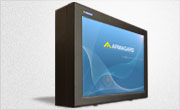The Hidden Challenges to Installing an Outdoor Screen
Posted by: Richard Williams | Posted on: | 0 Comments
With such rising popularity, outdoor digital signage is becoming an important part of external marketing for many businesses. Increasingly, more and more information screens are being used outside too, especially around transport hubs, and schools and colleges. Part of the rise in outdoor screen use is due to the falling cost of LCD screens and the availability of protective systems such as
While it is obvious that most outdoor screens whether they are used for providing promotional material or straight information, require protection from the elements, using outdoor screens does have some hidden challenges too:
Permissions
Unless it’s on private property, you can’t just place a screen outdoors without asking permission from the relevant authorities. In some locations, this can be a nightmare, with risk assessments, planning permissions and even conservation laws to be negated, resulting in a mountain of paperwork.
Mounting a screen on your own property, such as on the side of the building, usually doesn’t require permissions, although it is always worth checking with local authorities before you go ahead as different councils have different strategies when it comes to outdoor digital signage.
Networking/Installation
Placing a screen outdoors can be tricky when it comes to finding power access and networking. Again, if connected to your own property, things should be much easier, but there could be a high installation cost of running network and power cables through walls. Using a simple solution where content is uploaded manually through a USB slot can halve the headache.
Sunlight
The sun can play havoc with outdoor screens. Not only can the sun cause glare, making screens difficult to read. The sun can also overpower the screen’s brightness, making the content virtually invisible. For this reason, any outdoor screen needs to be as bright as possible. Screen brightness is measured in candela (or nits) with standard indoors screens luminous to about 500 candela; for outdoors 12-1,500 candela should be used.
Physical Protection
Making sure an outdoor screen is secured from theft and vandalism is also necessary. Often outdoor screens are left unattended overnight or for prolonged periods so the display needs some form of physical protection such as that provided by Armagard’s LCD enclosure range.
Post shortlink:
Popular Products
LCD Enclosure
Need armor for your LCD/LED screen(s)? Outdoors or inside the versatile LCD enclosure protects against thieves, vandals & the weather. Installation idea: NFL stadiums.
Outdoor Digital Signage
Exclusive 46” outdoor screen protection. Dubbed the ‘Totem’, due to its distinct design, it repels damage threats, but attracts audiences. Installation idea: Drive-thru restaurants.
Portrait Flat Panel Enclosure
Safeguard your eye-level advertising display screen(s), indoors or outdoors. Completely customizable, add exciting features like touch screen technology. Installation idea: Restaurant frontages.
Indoor Digital Signage
Popular purchase for retail outlets! Great for ‘point of sale’ persuasion, boost your brand with static & motion advertising from a single unit! Installation idea: Mall of America.





